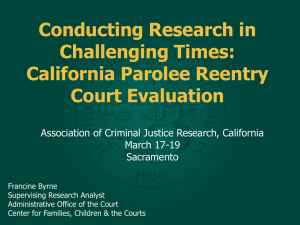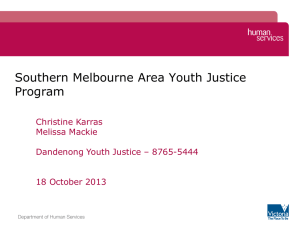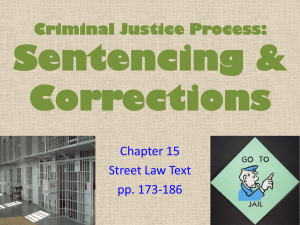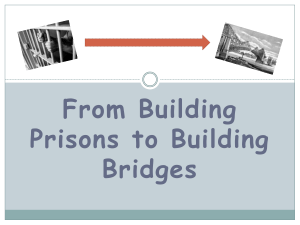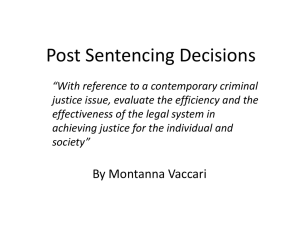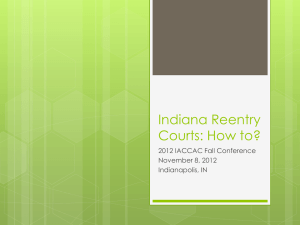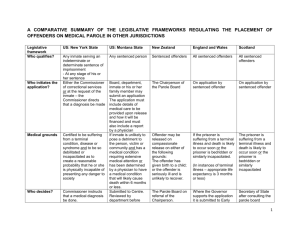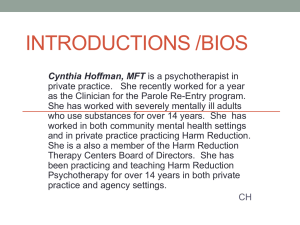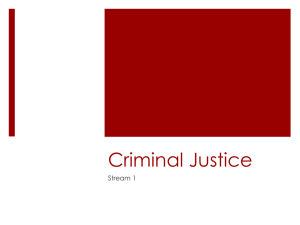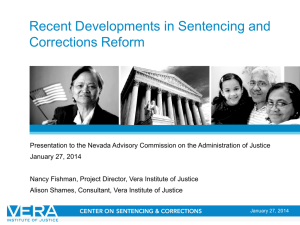Chapter 12 - Peru State College
advertisement
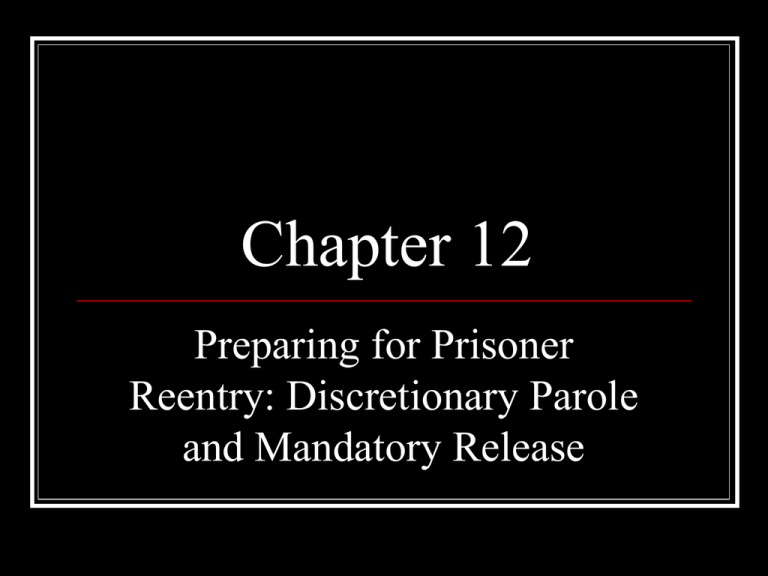
Chapter 12 Preparing for Prisoner Reentry: Discretionary Parole and Mandatory Release Introduction Prisoner reentry is any activity or program dedicated to preparing and integrating parolees into the community as law-abiding citizens using a collaborative approach with parole officers, treatment providers and the community. More than 95% of incarcerated prisoners will eventually be released: 650,000 every year. LO: 1 Issues in Reentry Successful reentry includes: Prerelease planning Community referrals Quick access to benefit programs and continuity of care LO: 1 Issues in Reentry, Con’t. Challenges for recently-released exoffenders include: Being indigent, but still requiring medications Being given a list of referrals versus having the appointments made for them Finding suitable employment, housing and staying clean of illegal drugs LO: 2 The Prisoner’s Family The prisoner’s family suffers during the period of confinement with the stigma of having a loved one behind bars The prisoner’s family plays a vital role in reentry, yet only 25% of prisoners have someone to meet them at release Reentry requires family ties to be reestablished or mended LO: 2 The Victim’s Role in Reentry Most victims are an intimate or an acquaintance of the offender. The offender has a responsibility to repair the harm done to the victim and the community. Discretionary parole is viewed as safer for the victim than releasing prisoners to the community without supervision. LO: 2 Reentry and the Community Certain areas of cities receive a disproportionate number of parolees and have a high amount of unemployment, drugs and instability and disorganization Some believe that reentry should encompass restorative justice and civic community service in a model of civic engagement if the community is willing to accept offenders returning to their communities. LO: 2 Community-Based Reentry Initiatives Other reentry initiatives are to allow employers who hire parolees and ex-felons to receive federal tax credits after the employee has worked a certain amount of time or has earned a certain amount of money. Reentry courts are a collaborative, team-based program that occurs after prison to improve the link between parole supervision and treatment providers. LO: 2 Types of Reentry The different types of reentry result from either determinate or indeterminate sentencing structures Determinate sentencing results in automatic or mandatory release Indeterminate sentencing results in discretionary release by a parole board LO: 3 Eligibility for Parole The first step in the reentry process is the eligibility of the offender for parole consideration. Some inmates are permanently ineligible for parole. Parole eligibility is determined by a combination of calendar days served and good time days earned. LO: 3 Parole Board Functions Parole boards have four basic functions: To decide when prisoners should be released To determine any special conditions of parole supervision To successfully discharge the parolee when conditions have been met To determine whether parole privileges should be revoked if the conditions are violated In addition, some parole boards are involved with executive clemency decisions LO: 3 Eligibility Dates The minimum eligibility date is the shortest amount of time defined by statute that must be served before an inmate is considered for parole by the parole board. The maximum eligibility date is the longest amount of time that can be served before the inmate must be released. LO: 3 Time Sheets and Eligibility Dates Good time (or “gain time”) is awarded for institutional good conduct and may be lost for misbehavior. Parole eligibility dates vary from state to state and offense-type to offense-type. LO: 3 Prerelease Preparation A prerelease facility is a minimum security program that houses inmates with good institutional conduct who are within 2 years of release. A prerelease plan includes a summary of institutional conduct and program participation as well as plans for housing and employment upon release, and: Increases an offender’s chances of parole Saves time during the parole hearing Reflects ties in the community that will assist in reentry LO: 1 The Parole Board Parole boards average 7 members, ranging from 3 to 19 in number. Most release decisions are made by panels of three members. Crimes of a violent or sexual nature may require a full board review. In most states that retain parole boards, the governor appoints members for an average of 5 years, with varying qualifications. LO: 3 Parole Boards Have 4 Basic Functions: To decide when individual prisoners should be released To determine any special conditions of parole supervision To successfully discharge the parolee when the conditions have been met To determine whether parole privileges should be revoked or should the conditions be violated LO: 3 The Parole Hearing The options for parole decision makers are: Grant parole, resulting in conditional release Deny parole, resulting in continued imprisonment Defer to a later date, resulting in a delay of the grant or deny decision, typically by 6 months to a year The sentencing judge, prosecutor and defense attorney often provide recommendations. LO: 3 Victim Impact A victim impact statement mentions how the crime has taken a toll physically, emotionally, financially, and/or psychologically on the victim and the victim’s family. Parole was refused in 43% of cases in which victim impact statements were present, but only 7% of cases were denied when victim statements were absent. LO: 2 Models of Parole Release Decisions Statutes typically direct parole boards to base their decisions on: The probability of recidivism The welfare of society The conduct of the offender while incarcerated The sufficiency of the parole plan LO: 3 3 Models The models guiding parole decision making are: The surveillance model The procedural justice model “an attempt to control “the dangerous classes” Advocates fairness and legal factors, i.e., guidelines The risk prediction model Utilizes offense severity and risk of recidivism, resulting in the salient factor score LO: 3 Due Process During Parole Hearings Menechino v. Oswald (1971) The Supreme Court ruled that parole was a privilege not a right. Greenholtz v. Inmates of the Nebraska Penal and Correctional Complex (1979) Established minimal due process protections in the parole granting process. LO: 4 Right to Attorney Prisoners seeking parole do not have the right to be represented by counsel. While a lawyer is welcome to attend in support of the prisoner, the lawyer may not represent or talk for a prisoner during a parole hearing (Franciosi v. Michigan Parole Board 2000). LO: 4
